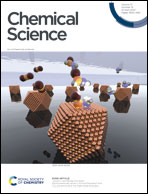Pt(ii)-coordinated tricomponent self-assemblies of tetrapyridyl porphyrin and dicarboxylate ligands: are they 3D prisms or 2D bow-ties?†
Abstract
Thermodynamically favored simultaneous coordination of Pt(II) corners with aza- and carboxylate ligands yields tricomponent coordination complexes with sophisticated structures and functions, which require careful structural characterization to paint accurate depiction of their structure–function relationships. Previous reports claimed that heteroleptic coordination of cis-(Et3P)2PtII with tetrapyridyl porphyrins (M′TPP, M′ = Zn or H2) and dicarboxylate ligands (XDC) yielded 3D tetragonal prisms containing two horizontal M′TPP faces and four vertical XDC pillars connected by eight Pt(II) corners, even though such structures were not supported by their 1H NMR data. Through extensive X-ray crystallographic and NMR studies, herein, we demonstrate that self-assembly of cis-(Et3P)2PtII, M′TPP, and four different XDC linkers having varied lengths and rigidities actually yields bow-tie (![[X triangles, left, right]](https://www.rsc.org/images/entities/char_22c8.gif) )-shaped 2D [{cis-(Et3P)2Pt}4(M′TPP) (XDC)2]4+ complexes featuring a M′TPP core and two parallel XDC linkers connected by four heteroleptic PtII corners instead of 3D prisms. This happened because (i) irrespective of their length (∼7–11 Å) and rigidity, the XDC linkers intramolecularly bridged two adjacent pyridyl-N atoms of a M′TPP core via PtII corners instead of connecting two cofacial M′TPP ligands and (ii) bow-tie complexes are entropically favored over prisms. The electron-rich ZnTPP core of a representative bow-tie complex selectively formed a charge-transfer complex with highly π-acidic 1,4,5,8,9,12-hexaazatriphenylene-2,3,6,7,10,11-heaxacarbonitrile but not with a π-donor such as pyrene. Thus, this work not only produced novel M′TPP-based bow-tie complexes and demonstrated their selective π-acid recognition capability, but also underscored the importance of proper structural characterization of supramolecular assemblies to ensure accurate depiction of their structure–property relationships.
)-shaped 2D [{cis-(Et3P)2Pt}4(M′TPP) (XDC)2]4+ complexes featuring a M′TPP core and two parallel XDC linkers connected by four heteroleptic PtII corners instead of 3D prisms. This happened because (i) irrespective of their length (∼7–11 Å) and rigidity, the XDC linkers intramolecularly bridged two adjacent pyridyl-N atoms of a M′TPP core via PtII corners instead of connecting two cofacial M′TPP ligands and (ii) bow-tie complexes are entropically favored over prisms. The electron-rich ZnTPP core of a representative bow-tie complex selectively formed a charge-transfer complex with highly π-acidic 1,4,5,8,9,12-hexaazatriphenylene-2,3,6,7,10,11-heaxacarbonitrile but not with a π-donor such as pyrene. Thus, this work not only produced novel M′TPP-based bow-tie complexes and demonstrated their selective π-acid recognition capability, but also underscored the importance of proper structural characterization of supramolecular assemblies to ensure accurate depiction of their structure–property relationships.



 Please wait while we load your content...
Please wait while we load your content...